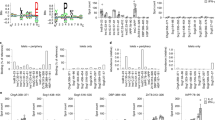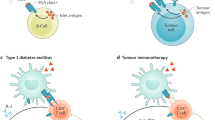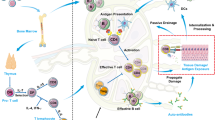Abstract
Arising from: M. Nakayama et al. Nature 435, 220–223 (2005) and S. C. Kent et al. Nature 435, 224–228 (2005); D. A. Hafler et al. reply
Spontaneous type 1 diabetes occurs when the autoimmune destruction of pancreatic β-islet cells prevents production of the hormone insulin. This causes an inability to regulate glucose metabolism, which results in dangerously raised blood glucose concentrations. It is generally accepted that thymus-derived lymphocytes (T cells) are critically involved in the onset and progression of type 1 diabetes, but the antigens that initiate and drive this destructive process remain poorly characterized — although several candidates have been considered1. Nakayama et al.2 and Kent et al.3 claim that insulin itself is the primary autoantigen that initiates spontaneous type 1 diabetes in mice and humans, respectively, a result that could have implications for more effective prevention and therapy. However, I believe that this proposed immunological role of insulin may be undermined by the atypical responses of T cells to the human insulin fragment that are described by Kent et al.3.
Similar content being viewed by others
Main
Nakayama and colleagues2 eliminated the normal insulin genes in a non-obese diabetic (NOD) mouse model and replaced them with an engineered gene encoding insulin that is hormonally active but fails to stimulate T-cell responses. The mice did not develop insulin antibodies, inflammation of β-islet cells (insulitis), or diabetes. This important and surprising finding indicates that the absence of an immune response to a single fragment of the insulin B-chain, residues 9–23, could be sufficient to prevent onset of a disease that might be expected to be mediated by immune reactivity to many other potential β-cell autoantigens.
How could this happen? T cells recognize, and are activated by, antigenic peptide fragments bound to gene products of the major histocompatibility complex (MHC). CD4+ T cells in the NOD mouse recognize the insulin B9–23 fragment complexed to the I–Ag7 MHC class II molecule4; CD8+ T cells recognize a related fragment, B15–23, in association with the H–Kd class I MHC molecule5. The mutated insulin transgene used by Nakayama et al. encodes a molecule with a tyrosine-to-alanine replacement at residue 16: presumably this causes the B9–23 fragment to bind with insufficient avidity to this I–Ag7 molecule and/or failure of the B15–23 peptide to bind to H–Kd, making these insulin fragments unrecognizable to the T-cell-receptor repertoire. Prevention of diabetes in these NOD mice therefore involved replacing an immunogenic and hormonally active insulin molecule with a nonimmunogenic one.
Kent and colleagues3 recovered T-cell lymphocytes from the pancreatic-draining lymph nodes of diabetic patients, cloned them and attempted to identify the protein antigen fragments recognized by these T cells. Remarkably, a substantial proportion (about 50%) of CD4+ T cells recognized the amino-terminal fragment (residues 1–15) of the insulin A-chain. More surprising, however, is that the proliferative responses by these clones to the insulin peptide were at best minimal: stimulation indices were three- to sixfold; one of three clones gave an 80-fold increase in interleukin-13 production, whereas the other two produced interleukin-13 in amounts that were only three to six times above background; and very large amounts of peptide (1 mM, or about 1.6 mg ml−1) were required to elicit these responses.
These seem to be valid T-cell responses in that they can be blocked by monoclonal antibodies against MHC class II peptides, but they are notably atypical in the amount of antigen required for stimulation and in the level of the resulting response. For example, this does not compare with the functional avidity of most myelin-specific CD4+ T cells from patients with multiple sclerosis, which have EC50 values (where EC50 is the effective concentration of antigen that causes half-maximal response) in the range 1–50 µM (ref. 6), corresponding to an antigen concentration that is 200–1,000-fold lower; also, a typical encephalitogenic CD4+ T-cell clone in experimental allergic encephalomyelitis, an autoimmune murine model for multiple sclerosis, requires a concentration of a myelin basic protein peptide fragment in the 300 nM range (about 300 ng ml−1) for activation7, which is 5,000-fold lower.
The results of Kent et al. may indicate either that the native ligand for these pancreatic lymph-node T-cell clones uses a sequence other than the first 15 residues of the insulin A-chain and is a different nominal antigen that may be unrelated to the autoimmune process, or that these anti-insulin clones have a very low avidity. But in the latter case, where in the body would the required concentration of insulin peptide be available to activate these cells?
References
Castano, L. & Eisenbarth, G. S. Annu. Rev. Immunol. 8, 647–679 (1990).
Nakayama, M. et al. Nature 435, 220–223 (2005).
Kent, S. C. et al. Nature 435, 224–228 (2005).
Abiru, N. et al. J. Autoimmun. 14, 231–237 (2000).
Wong, F. S., Moustakas, A. K., Wen, L., Papadopoulos, G. K. & Janeway, C. A. Jr Proc. Natl Acad. Sci. USA 99, 5551–5556 (2002).
Muraro, P. A., Pette, M., Bielekova, B., McFarland, H. F. & Martin, R. J. Immunol. 164, 5474–5481 (2000).
Kumar, V. et al. Proc. Natl Acad. Sci. USA 92, 9510–9514 (1995).
Author information
Authors and Affiliations
Rights and permissions
About this article
Cite this article
Wilson, D. Insulin auto-antigenicity in type 1 diabetes. Nature 438, E5 (2005). https://doi.org/10.1038/nature04423
Published:
Issue Date:
DOI: https://doi.org/10.1038/nature04423
This article is cited by
-
The vicious cycle of apoptotic β‐cell death in type 1 diabetes
Immunology & Cell Biology (2007)
-
Insulin auto-antigenicity in type 1 diabetes (Reply)
Nature (2005)
Comments
By submitting a comment you agree to abide by our Terms and Community Guidelines. If you find something abusive or that does not comply with our terms or guidelines please flag it as inappropriate.



